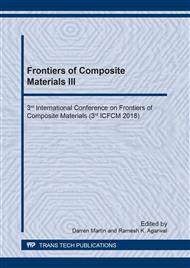p.45
p.51
p.57
p.63
p.71
p.77
p.83
p.89
p.97
Feasibility Study of Pressure Boiled Method on Defibrillation Stalk Sweet Sorghum Fibres Waste
Abstract:
Today, due to environmental reasons and limited of fossil resources take many researchers to develop new and renewable materials. Bio-composites which is consisted of synthetic polymers matrix and natural fibres, is one of the alternatives to reducing its problems. Among of natural fibre that has good potential to be used as reinforcement in synthetic polymer matrices is sorghum fibre. However the hydrophilic nature of natural fibers causes it to be incompatible with synthetic polymer matrices which have hydrophobic properties and it’s need to surface modified with particular treatment. The aim of this work was conducted to study the effect of hydrothermal treatment through pressure boiled method by using distilled water in a pressurized stainless steel pan cooking for 5 minutes to defibrillation and hydrophilic properties of stalk sweet sorghum fibres. Evaluation of the experiments was characterized with Field-Emission Scanning Electron microscope (FE-SEM), Fourier Transformation Infra-Red (FTIR) Spectroscopy and sessile drop test instruments, respectively. The experiment was found that using hydrothermal treatments through pressure boiled method led to a removal of binding materials, such as a wax, hemicellulose and lignin, and enhancement the hydrophilic properties of sorghum fibres.
Info:
Periodical:
Pages:
71-75
Citation:
Online since:
April 2019
Authors:
Keywords:
Price:
Сopyright:
© 2019 Trans Tech Publications Ltd. All Rights Reserved
Share:
Citation:


